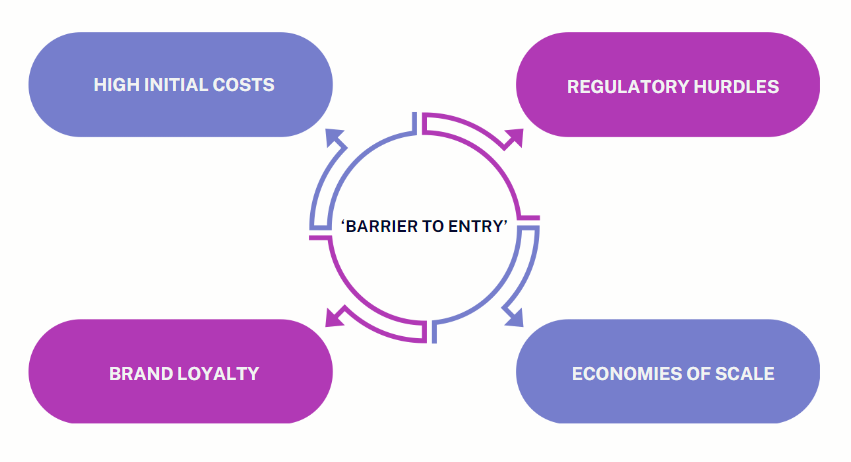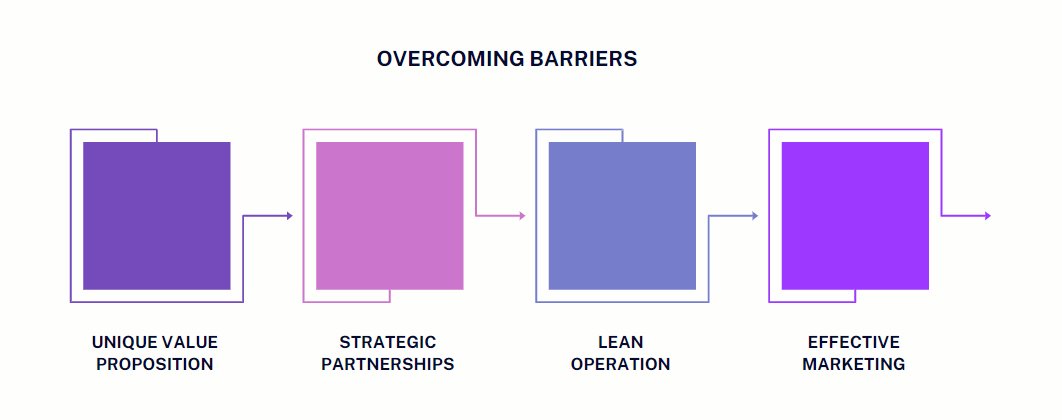Barriers to entry are obstacles that make it difficult for new firms to enter a market. These barriers play a crucial role in market competition by protecting established companies from new competitors. Regardless of the stage of your firm, you should have a solid understanding of barriers to entry.

With this knowledge, you can break into an industry and strategize to combat existing firms that have a stronghold of the market position. The following article outlines the different types of barriers to entry, their impact on competition, and strategies for overcoming them.
What are barriers to entry?
Barriers to entry are factors that prevent or hinder new companies from entering an industry or market. These obstacles can be natural, economic, technological, or even created by existing firms. Existing firms want to maintain dominance in a specific market and barriers to entry help you sustain a competitive edge.
Some examples of these barriers:

- High initial costs — When large capital investment is required to start a business
- Regulatory hurdles — Strict government regulations and compliance requirements
- Brand loyalty — Strong customer preference for established brands
- Economies of scale — Cost advantages enjoyed by established firms due to large-scale production capacity
- Access to distribution channels — Refers to the difficulty faced by new firms when trying to secure distribution networks dominated by existing players
3 types of barriers to entry
When it comes to barriers to entry, identifying the specific type you face helps you develop a better strategy. The following three tend come up the most:
- Natural — These arise from the inherent characteristics of the industry. For instance, several niche markets require high capital in order to have a chance to break into them
- Artificial — Created by existing firms to prevent new competitors. It includes tactics like aggressive marketing and exclusive agreements
- Structural — Linked to the overall structure and regulations of the industry. For example, regulatory hurdles and intellectual property (patents and trademarks) to protect innovations and prevent replication by new entrants
Impact of barriers to entry on competition
Barriers to entry play a significant role in shaping market dynamics. They determine the ease of new competitors entering the market. Four main impacts come from barriers to entry:

- Reduced competition
- Innovation stagnation
- Price stability
- Market power stasis
High barriers to entry limit the number of new entrants, allowing existing companies to maintain market position. With fewer competitors, existing firms may have less incentive to innovate and ultimately stagnate.
Pros and cons of barriers to entry
When it comes to impact, barriers to entry can come with benefits or drawbacks. By understanding both, you can make better informed decisions about whether to defend a current market position or break into something new.
Benefits
Barriers to entry help you:
- Protect existing investment
- Ensure stability and predictability in the market
- Encourage improved efficiency and quality to maintain market position
Drawbacks
On the other hand, barriers to entry come with drawbacks as they can:
- Limit consumer choices due to fewer competitors
- Lead to monopolistic practices and higher prices
- Potentially stifle innovation and technological advancement
Real-world examples of barriers to entry
To help further illustrate barriers to entry, consider the following examples of them in action:
- Pharmaceutical industry — Regulatory hurdles and high R&D costs act as significant barriers. Such barriers limit new entrants, but ensure drug safety and efficacy
- Telecommunications — High infrastructure costs and regulatory requirements prevent easy market entry in this domain. As a result, only a few key players exist
- Automotive industry — In the automotive industry, economies of scale and brand loyalty create barriers. This protects established automakers from new competitors. For instance, Tesla dominates the electric vehicle market
How to overcome barriers to entry
New entrants face significant challenges when attempting to break into established markets. However, with the right strategies, these barriers can be tackled. If you want to overcome barriers, try these strategies:

- Develop unique, innovative products or provide services
- Form alliances with established players to gain market access and share resources
- Lean down the operations and focus on cost efficiency
- Aim to build strong brand awareness and customer loyalty through targeted marketing campaigns
Key takeaways
Barriers to entry shape the competitive landscape of any industry. For aspiring start-ups and established companies alike, understanding these barriers helps you develop an effective marketing campaign and sustain growth.
Try to remember the following key takeaways:
- Assess specific barriers in your target industry
- Develop unique products or services to stand out
- Collaborate with established players for market access
- Focus on cost efficiency and lean operations
- Invest in expertise to manage compliance effectively
- Build strong brand awareness and customer loyalty
Good luck! Comment with questions.
Featured image source: IconScout